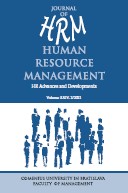Separation planning, human resource practices and pre-retiree decisions: making retirement preparedness work
Separation planning, human resource practices and pre-retiree decisions: making retirement preparedness work
Author(s): Githaiga Gathiira, Stephen M. A. MuatheSubject(s): Behaviorism, Human Resources in Economy, Socio-Economic Research
Published by: Fakulta managementu Univerzity Komenského v Bratislave
Keywords: separation planning; human resource practices; pre-retiree decisions; retirement preparedness; teachers in Kenya;
Summary/Abstract: Purpose – Employee separation planning decisions is one of the Human Resource Management functions that are neglected both in theory and practice by both individuals and organizations. Most studies usually employ few measures to explain the ever allusive retirement preparedness. To fill the gap, we propose a five multi-measure model employed to pre-retiree teachers in Kenya. Aim – The primary objective is to measure separation planning on retirement preparedness of preretirees’ teachers in Kenya. Methodology – Hypothesis testing was employed to measure retirement preparedness of the preretirees using five-element model that included mediating and moderating variables. The five hypothesis were tested and analyzed using logit regression. A representative sample (N=334) was employed on 1,238 pre-retiree teachers aged 50 years and above, using three stage-multistage sampling. Findings – Four of the five null hypothesis were rejected. The pre-retiree teachers were found wanting in retirement preparedness. Separation planning programmes had a significant relationship with retirement preparedness while pre-retiree decisions exhibited partial mediation to the relationship between separation planning programmes and retirement preparedness. Human resource practices failed to moderate separation planning programmes and retirement preparedness relationship but had a significant positive relationship with retirement preparedness. Limitation of the Study – The study was conducted in two Counties and in the educational sector, a profession with unique and strict code of service, thus limiting extent of generalizations. In addition, cross-sectional design failed to provide the time lag implications. Practical implication – HR Practitioners need to respond to separation planning as Strategic HRM issue, and specifically re-invent employer contribution in worker’s preparation for retirement as an Employee Value Preposition (EVP) element. Pre-retiree teachers ought to take part in diversified activities geared towards separation planning for retirement wellbeing in postemployment life as an all-inclusive and holistic approach. Frameworks that enforce, monitor and evaluate retirement programmes in employer institutions should be enacted by the government for provision of employee-employer nexus in separation planning for retirement wellbeing. Originality/Value – The outcome contributes and enriches the body of knowledge in Human Resource Management. The findings have far reaching implications to policy makers and practitioners alike.
Journal: Journal of Human Resource Management
- Issue Year: 24/2021
- Issue No: 2
- Page Range: 36-59
- Page Count: 24
- Language: English

